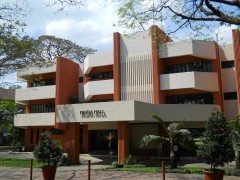Satellite remote sensing products from JAXA that may serve the needs of Manila Observatory
July 27, 2011 Leave a comment
by Nofel Lagrosas
Hi all,
I have attached the excel file that each program has to fill up to show MO’s needs to explore satellite remote sensing products from JAXA. I have partially filled the ITD/UAQ side.
Below are some Japanese (and collaborators’) earth observation satellites:
1. GOSAT (IBUKI satellite) data – for monitoring of carbon dioxide (or green house gases) in the atmosphere
2. ALOS (DAICHI satellite) – A Japanese satellite designed to observe and map Earth’s surface, to enhance cartography, monitor natural disasters, and survey land use and natural resources to promote sustainable development. The four-ton ALOS follows JERS and ADEOS, and will extend the database of these earlier satellites using three remote-sensing instruments: the Panchromatic Remote-sensing Instrument for Stereo Mapping (PRISM) for digital elevation mapping, the Advanced Visible and Near Infrared Radiometer type 2 (AVNIR-2) for precise land coverage observation, and the Phased Array type L-band Synthetic Aperture Radar (PALSAR) for day-and-night and all-weather land observation.
3. AQUA
4. GCOM – Japanese Earth resources satellites planned for launch over the coming decade to improve the accuracy of global observations begun by ADEOS and collect data on worldwide environmental change over a period of up to 15 years. GCOM-A1 will carry instruments to monitor concentrations of ozone, CFCs, and major greenhouse gases, such as carbon dioxide and nitrogen oxide. GCOM-B1 will study the large-scale circulation of energy and materials using the Second Generation ion Global Imager (SGLI) and the follow-on of the Advanced Microwave Scanning Radiometer(AMSR). It may also carry NASA’s Alpha SCAT and CNES’s (the French Space Agency’s) Polarization and Directionality of Earth’s Reflectance (POLDER). GCOM-B1 will be able to study the distribution of aerosols and water vapor, and make measurements of ice coverage, phytoplankton concentrations, and sea surface wind directions.
5. GPM – precipitation. GPM is designed to make more accurate and frequent observation of tropical rainfall by expanding its observing areas to higher latitudes.
6. EarthCARE – cloud, aerosol and radiation. EarthCARE is a joint European-Japanese mission addressing the need for a better understanding of the interactions between cloud, radiative and aerosol processes that play a role in climate regulation. The EarthCARE mission aims to improve the representation and understanding of the Earth’s radiative balance in climate and numerical weather forecast models by acquiring vertical profiles of clouds and aerosols, as well as the radiances at the top of the atmosphere.
7. TRMM – precipitation
8. ADEOS – ADEOS 1, also known by its national name Midori meaning “green,” was the first resources satellite to observe our planet from space in an integrated way. Developed and managed by Japan’s NASDA (National Space Development Agency), it carried eight instruments supplied by NASDA, NASA, and CNES (the French space agency) to monitor worldwide environmental changes, including global warming, depletion of the ozone layer, and shrinking of tropical rainforests. Due to structural damage, the satellite went off-line after only nine months in orbit.
ADEOS 2 continued where its predecessor left off, but also studied the global circulation of energy and water. It contributed to NASA’s EOS (Earth Observing System) by carrying NASA’s Seawinds scatterometer, a microwave radar to measure near-surface wind velocity and oceanic cloud conditions, which scientists hoped would improve their ability to forecast and model global weather. However, all communication with ADEOS 2 was lost in October 2003, probably as a result of heightened solar flare activity at the time. Its active lifetime had been roughly the same as that of its predecessor.
9. GEOSTATIONARY METEOROLOGICAL SATELLITE (GMS – HIMAWARI) – A series of weather satellites managed by the Japanese Meteorological Agency and NASDA (National Space Development Agency); their indigenous name Himawari means “sunflower.” All have been located in geostationary orbit at 140° E. The first GMS was launched in 1977 and the most recent, GMS-5, on Mar. 18, 1995. GMS-5 is equipped with a VISSR (Visible and Infrared Spin Scan Radiometer), which scans Earth’s surface line by line, each line consisting of a series of pixels. For each pixel the radiometer measures the radiative energy at three different wavelengths bands ? one in the visible region and two in the infrared.
10. JAPANESE EARTH RESOURCES SATELLITE (FUYO) – Japanese Earth observation satellite launched by NASDA (National Space Development Agency); also known by the national name Fuyo. Following on the success of MOS, JERS tested the performance of optical sensors and a synthetic aperture radar, and made observations for use in land survey, agriculture, forestry, fishery, environmental preservation, disaster prevention, and coastal surveillance. Some of its data were shared with the University of Alaska for research purposes.
11. MARINE OBSERVATION SATELLITE (MOS) – Japan’s first Earth resources satellites, also known by the national name Momo (“peach blossom”). MOS-1A and -1B, launched by NASDA (National Space Development Agency), monitored ocean currents and chlorophyll levels, sea surface temperature, atmospheric water vapor, precipitation, and land vegetation, and also acted as data relays for remote surface sensor platforms. Both measured 2.4 × 1.5 m and were launched from Tanegashima.
12. IONOSPHERE SOUNDING SATELLITE (ISS) – A pair of Japanese satellites, launched by NASDA (National Space Development Agency) and also known by their national name Ume (“plum”), that collected data on the ionosphere to aid in short-wave radio communication. Their instruments included an ionospheric sounder, a radio noise receiver, plasma measuring equipment, and an ion mass spectrometer. Both measured 3.9 × 0.8 m and were launched by N-1 rockets from Tanegashima.
Thanks!
Nofel

